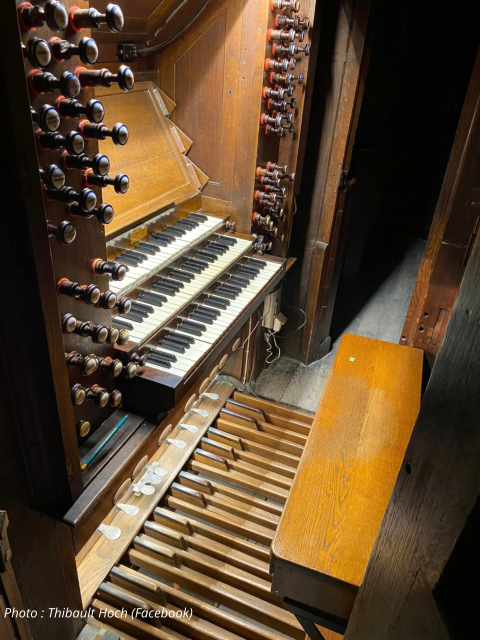


ORGANS OF PARIS © 2024 Vincent Hildebrandt HOME ALL ORGANS
Cathédrale
Saint-Denis
Place de la Légion d'Honneur, 93200 Saint-DenisOrgue de tribune OdC >
1841 - Aristide Cavaillé-Coll1857 - Aristide Cavaillé-Coll
1901 - Charles Mutin
1987 - Danion-Dargassies & Boisseau-Cattiaux
2000 - Charles Sarelot
III/70 - mechanical traction - stoplist


The Saint-Denis cathedral was the centre of innovation
at two moments in history:
(1) in 1140, Abbot Suger started the work of enlarging
the basilica, the result being often cited as the first
example of Gothic Architecture.
(2) in 1841 a new organ was inaugurated, built by a
young organ builder, Aristide Cavaillé-Coll (1811-1899),
on one hand still standing in the tradition of the organs
built in the past centuries by the Thierrys and the
Cliquots, on the other hand adding several revolutionary
and outstanding innovations which would form the
basis for the French symphonic organs which would
dominate the second half of the 19th century.
The church
On the remains of a Gallo-Roman cemetery, a first
church was built in 475 by St. Genevieve and a
second, greater, one in the 7th century by Dagobert I.
In the 12th century the Abbot Suger rebuilt the abbey
church using innovative structural and decorative
features that were drawn from a number of other
places. He created thus the first truly Gothic building.
In 1836, architect François Debret designed a new organ case
replacing an old organ which did not survive the revolution. A
competition was held to select the builer and several well-
known organ builders (Erard, Abbey, Dallery and Callinet)
submitted a design for the new organ. A few days before the
competition was closed, a young organ builder from
southern France arrived in Paris: Aristide Cavaillé-Coll (aged
24 years). He was informed about the competition, went
directly to St. Denis, worked for two days continuously on a
plan and submitted a superior and innovative design. He won
the competition, which can be seen as the birth of the french
symphonic organ tradition.
The organ was inaugurated in 1841, with several innovations:
- the swell box operated by a spring-loaded (later balanced)
pedal
- new stops imitating orchestral instruments (basson,
hautbois, clarinet) and the harmonic flute
- windchests divided into sections with different wind
pressures for fonds and reeds and introducing a pedal to add
or cancel all the reed stops of a manual
- use of many 8' stops (fonds)
- the Barker pneumatic lever machine to couple all the
manuals together and play without too much effort.
All these innovations allowed a seamless crescendo from
pianissimo to fortissimo, which was not possible before.
On the other hand, this organ was still very 'classic', with a full
32' grand plein jeu, the second manual for the Great Organ
and a classical 'French' pedal with a 'ravallement' from F and
a small swell.
In 1901, Charles Mutin carried out restoration works and the
number of stops was increased to 69, the pedal was
extended to C-c' (the c#' till f' are mute and speak only when
coupled).
In 1983-1987 the organ was restorated by Danion/Dargassies
(mechanical part) and Boisseau/Cattiaux (harmony and
voicing). The stops added by Mutin were removed.
More information
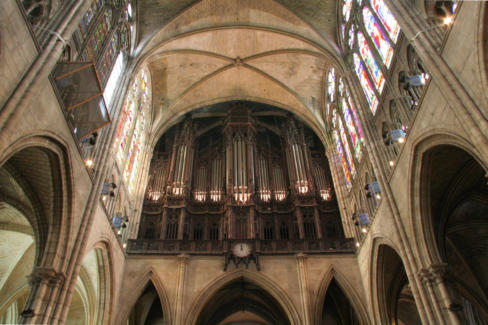
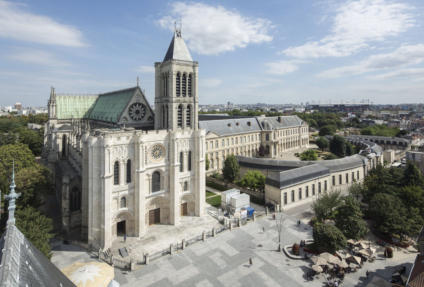
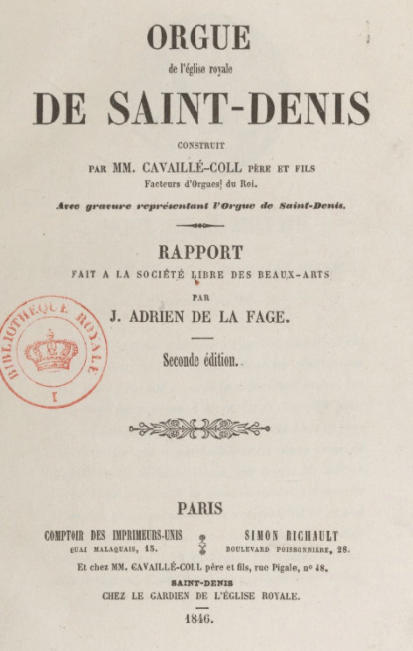
Organiste titulaire
Quentin Guérillot
Famous organists in the past:
Pierre Pincemaille (died on January, 12, 2018)
Concerts
Regularly
Masses with organ
Saturday 6.30 p.m., Sunday 11.15 a.m.
Video
Pierre Pincemaille
Photo organ case: Jeroen de Haan
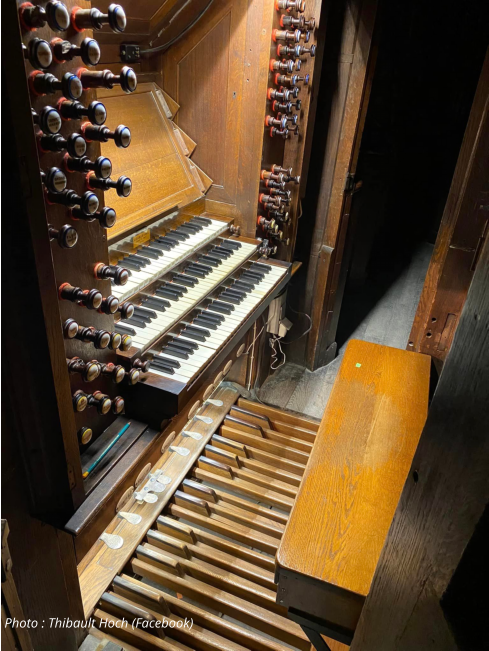
Organs of Paris
Cathédrale
Saint-Denis
Place de la Légion d'Honneur, 93200 Saint-DenisOrgue de tribune OdC >
1841 - Aristide Cavaillé-Coll1857 - Aristide Cavaillé-Coll
1901 - Charles Mutin
1987 - Danion-Dargassies & Boisseau-Cattiaux
2000 - Charles Sarelot
III/70 - mechanical traction - stoplist
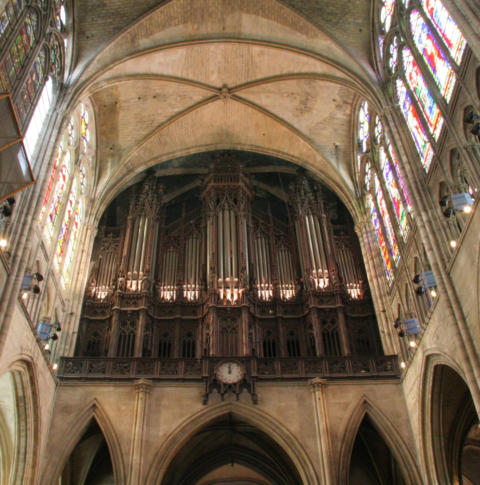
ORGANS OF PARIS © 2024 Vincent Hildebrandt ALL ORGANS
In 1836, architect François Debret designed a new organ case
replacing an old organ which did not survive the revolution. A
competition was held to select the builer and several well-
known organ builders (Erard, Abbey, Dallery and Callinet)
submitted a design for the new organ. A few days before the
competition was closed, a young organ builder from
southern France arrived in Paris: Aristide Cavaillé-Coll (aged
24 years). He was informed about the competition, went
directly to St. Denis, worked for two days continuously on a
plan and submitted a superior and innovative design. He won
the competition, which can be seen as the birth of the french
symphonic organ tradition.
The organ was inaugurated in 1841, with several innovations:
- the swell box operated by a spring-loaded (later balanced)
pedal
- new stops imitating orchestral instruments (basson,
hautbois, clarinet) and the harmonic flute
- windchests divided into sections with different wind
pressures for fonds and reeds and introducing a pedal to add
or cancel all the reed stops of a manual
- use of many 8' stops (fonds)
- the Barker pneumatic lever machine to couple all the
manuals together and play without too much effort.
All these innovations allowed a seamless crescendo from
pianissimo to fortissimo, which was not possible before.
On the other hand, this organ was still very 'classic', with a full
32' grand plein jeu, the second manual for the Great Organ
and a classical 'French' pedal with a 'ravallement' from F and
a small swell.
In 1901, Charles Mutin carried out restoration works and the
number of stops was increased to 69, the pedal was
extended to C-c' (the c#' till f' are mute and speak only when
coupled).
In 1983-1987 the organ was restorated by Danion/Dargassies
(mechanical part) and Boisseau/Cattiaux (harmony and
voicing). The stops added by Mutin were removed.
More information
Organiste titulaire
Quentin Guérillot
Famous organists in the past:
Pierre Pincemaille (died on January, 12, 2018)
Concerts
Regularly
Masses with organ
Saturday 6.30 p.m., Sunday 11.15 a.m.
Video
Pierre Pincemaille
Photo organ case: Jeroen de Haan
